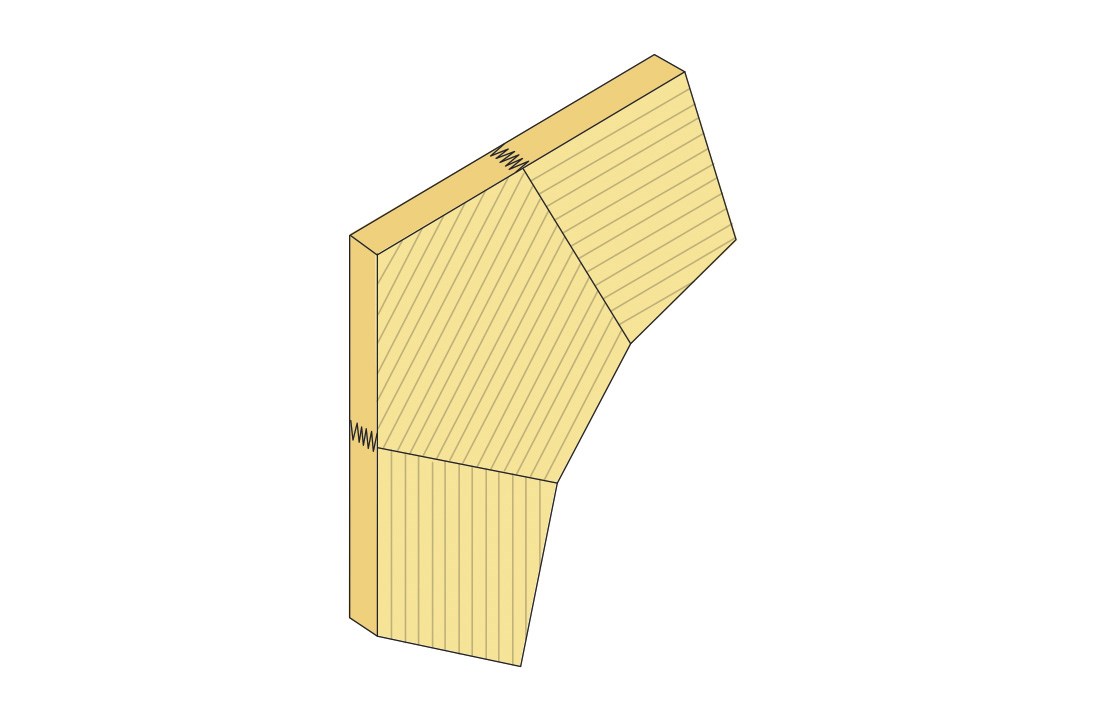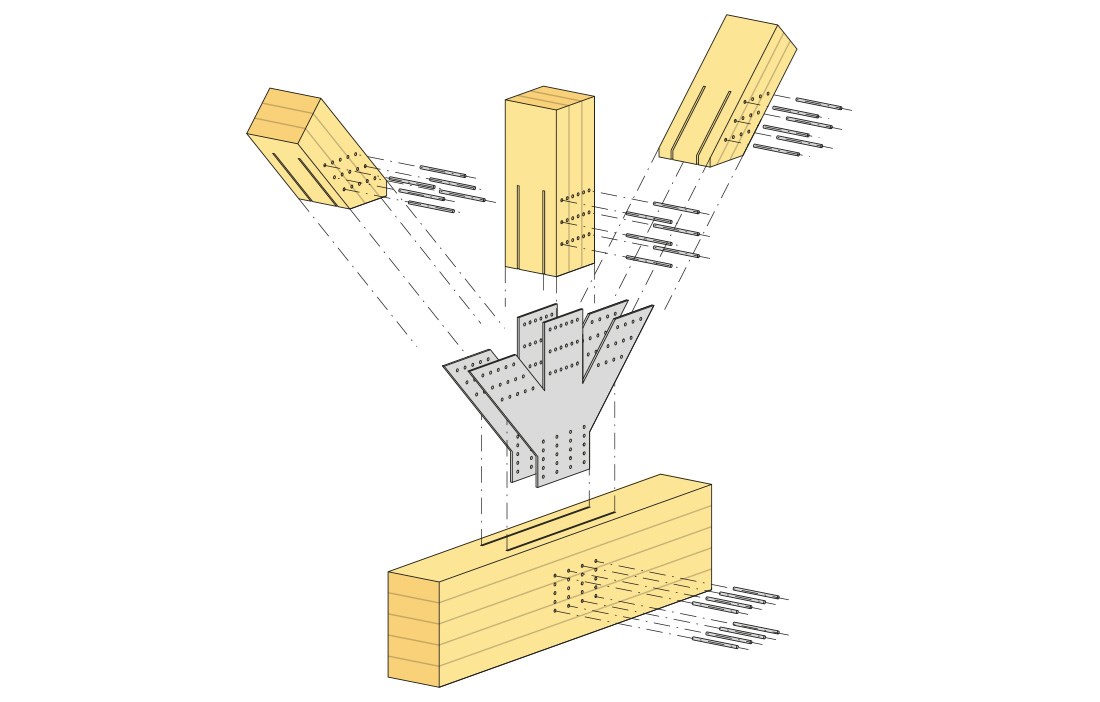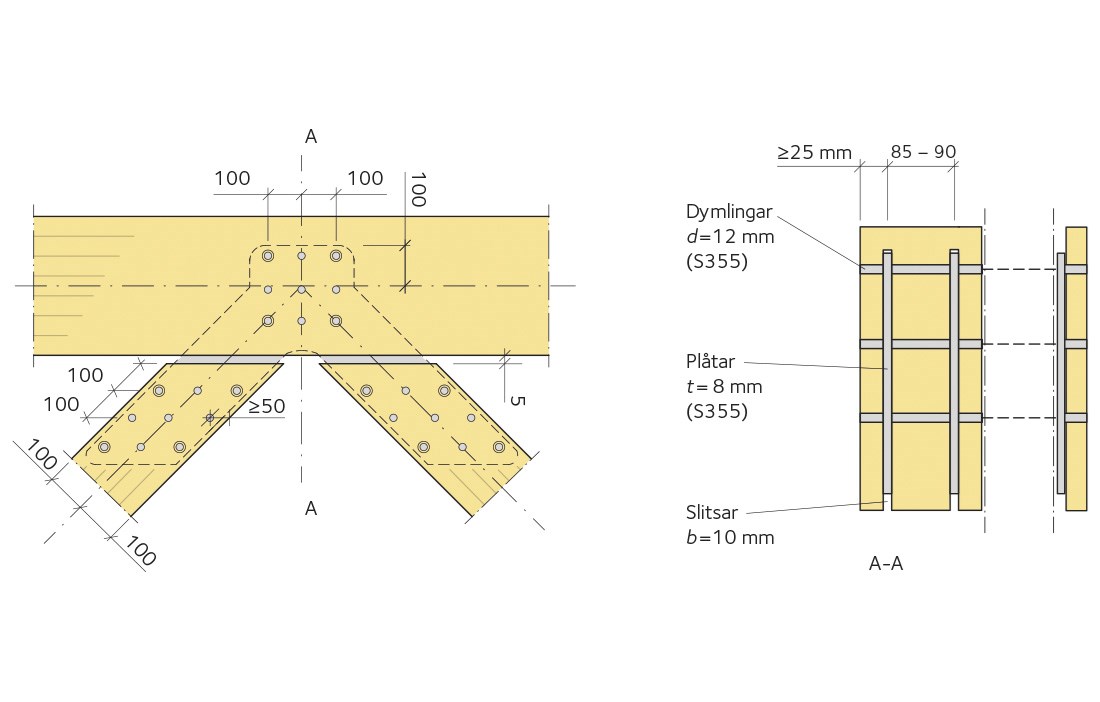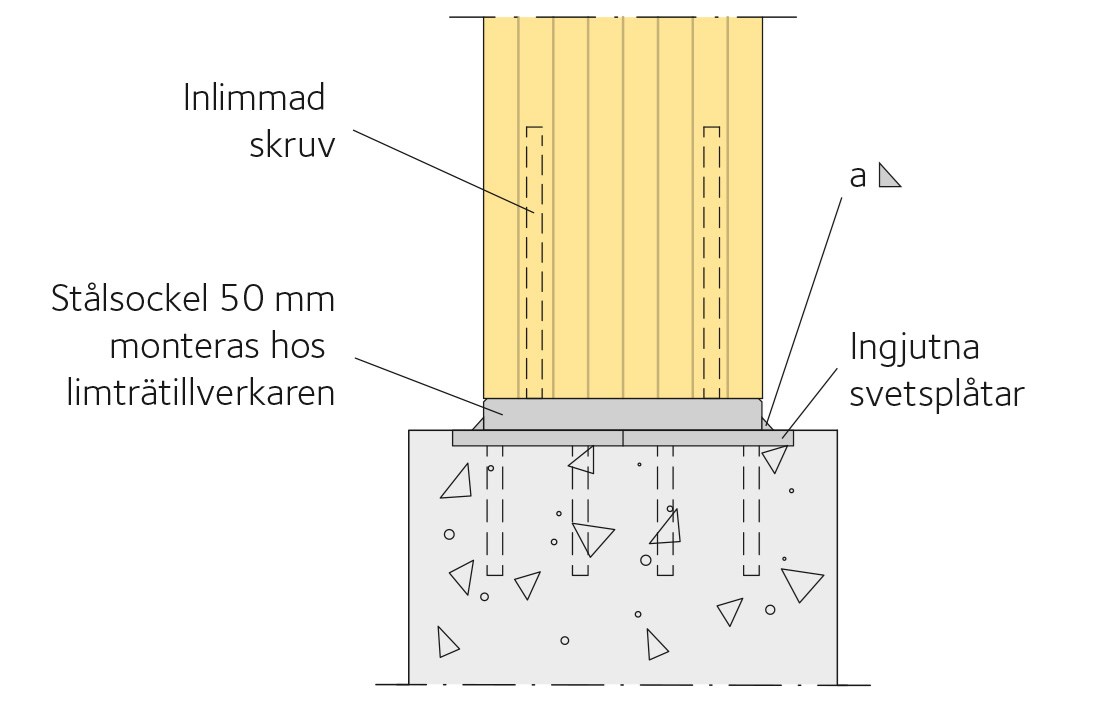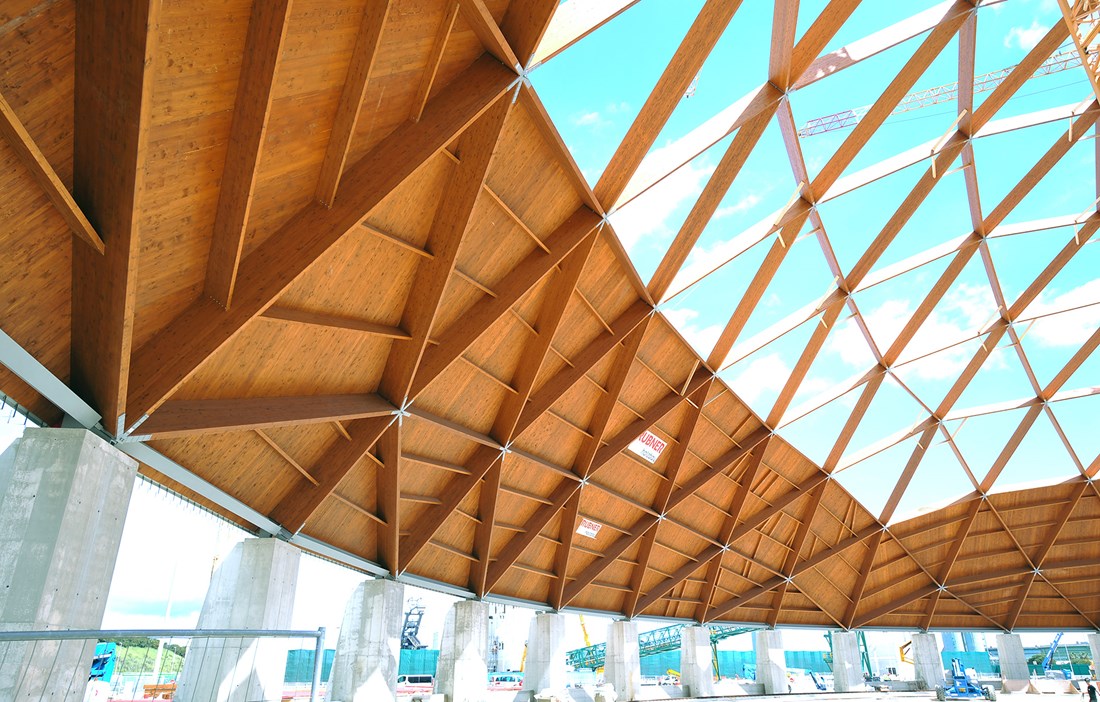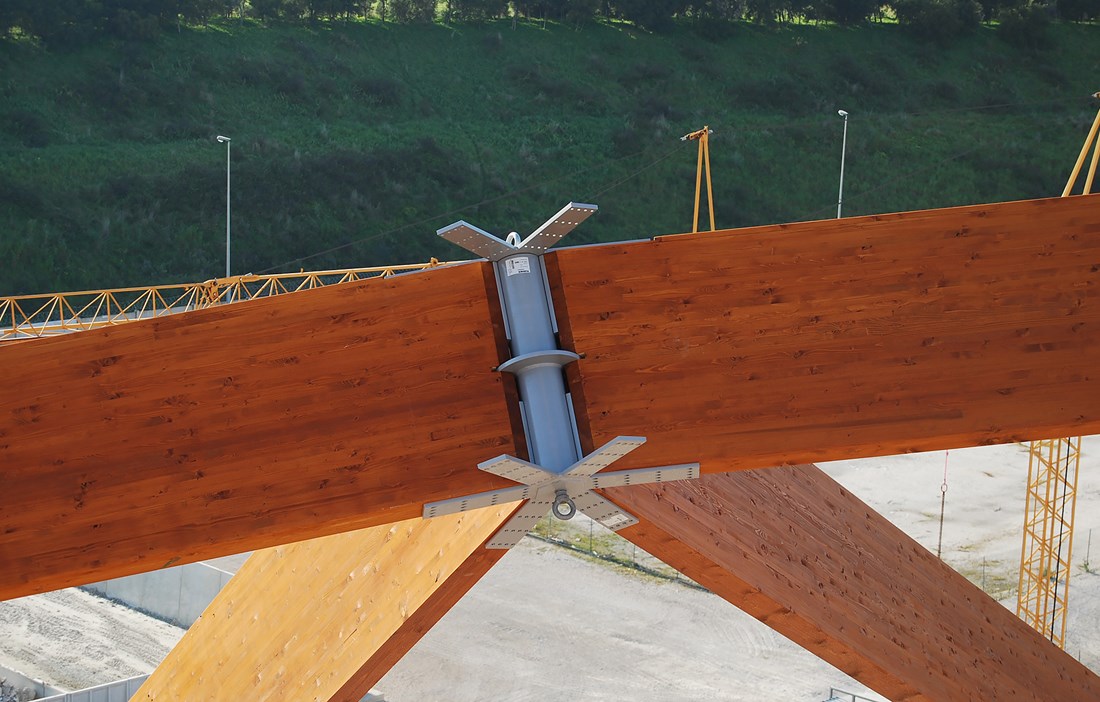Nails and steel plates with holes – these fixings transfer the force between the wood components with the help of steel plates with holes – nail plates or toothed plates – which are fixed to the wood with nails. The nail plates have pre-drilled or stamped holes in a pattern that meets the building standards concerning fixing distances. The thickness of the plates usually varies between 1.5 and 6 millimetres. The most common type of nail used in this case is the “anchor nail”, with a diameter of 4 millimetres and a length in the range of 40–60 millimetres. The fixing is very stiff and has a very good load-bearing capacity. The downsides are its unattractive look and the fact that it can often come up short on fire safety. When transferring axial forces in relatively wide timbers, it also reduces the static “effectiveness”.
Glued joint (large finger-joints) – in these joints the force is transferred between the timbers through shearing. A typical example is glulam frames with finger-jointed corners that are usually built up with a separate insert (figure 1). Glued joints offer outstanding strength and stiffness. However, gluing requires controlled environments for the actual production as many types of glue are affected by ambient humidity and temperature during curing. The usual recommendation is therefore for glued joints to be carried out in a factory. In some cases, a similar technique (gluing with the help of large finger-joints) has been used on the construction site, for example when erecting the famous wooden bridge in Essing, Germany. Hopefully, glue types and gluing techniques will be developed over the next few years to make gluing on site more practical.
Inset steel plates and dowels – this type of fixing comprises one or more steel plates that are inserted into pre-sawn slots in the timbers, plus a number of steel dowels that are placed in pre-drilled holes that run through the slots. There are also self-drilling dowels, usually 7 millimetres in diameter combined with 5 millimetre thick steel plates. Generally, the load-bearing capacity per dowel increases significantly as the number of inset plates rises. This type of fixing is highly effective when it comes to load absorption. This is currently the most common type of structural fixing for transferring large loads between timbers. The fixing is more or less equally as good at transferring both tensile and compression forces. Figure 2 shows the design principle of a truss joint with a fixing made up of two inset plates and multiple dowels. Joints with several inset plates are suitable for frames with large spans and large loads. In Norway and Sweden, many large scale trusses have been constructed for industrial and commercial buildings, sports facilities and bridges, using this particular technique. Since the 1990s, the practice in these countries has been for the inset plates to have a thickness of 8 millimetres, and for the dowels to have a diameter of 12 millimetres. The distance between the slots and between the slot and the outer face of the wood should be such that the fixing has a ductile character. This means that any break will not happen suddenly, but in a “soft manner”, as a consequence of relatively large-scale deformation (figure 3). As many as eight or nine inset plates have been used in very large glulam structures. Where there are more modest loads, one or two inset plates are often enough across the width. During the design phase, it is essential to bear in mind that slots and screw holes reduce the load bearing capacity, particularly for tie rods. To take account of the holes and slots during the preliminary design phase, it is generally acceptable to assume that the net cross-sectional area of the tie rods is around 60–80% of the gross cross-sectional area. The risk of the plate coming away and taking a block of wood with it must also be considered. Joints made using inset plates and dowels have good fire safety properties and are often aesthetically pleasing. On the other hand, such fixings are relatively expensive in both material and production terms.
Glued-in rods – using glued-in rods keeps the fixing completely hidden. This type of fixing is thus excellent on the fire safety front. The individual glued-in rods can transfer relatively large tensile and compression forces. However, the requirements concerning the distance between the rods and between the rods and the outer face of the wood are quite restrictive. As such, only a limited portion of the wood’s cross-section can be used for gluing in rods. As a result, the load capacity tends to be lower here than for joints that use inset plates and dowels, for example. There are wooden structures, not least in Switzerland, that use glued-in rods with extremely strong woods such as beech and ash. Choosing these woods makes it possible to reduce the centre spacing between the glued-in rods and use higher strength values. Designers have used this technique to construct wooden trusses with impressive dimensions. Glued-in rods cannot be used in structures in climate class 3 (outdoor structures) or in structures subject to dynamic loads (figure 4).
Oblique screws and cover plates – using oblique wood screws has become increasingly popular over the past decade. The most commonly occurring angle between the screw and the fibre direction is 45 degrees, which is a good compromise between ease of assembly and load capacity. Oblique wood screws can transfer significantly larger loads than equivalent wood screws that are inserted in the traditional way, i.e. at right angles to the fibre direction. The reason for the higher load capacity is that the oblique screw transfers the load primarily in a tensile way rather than in a shearing way, as occurs in traditional screwed joints. The oblique screw joint can either have parallel wood screws or pairs of crossed wood screws (figure 5). In figure 5a, two parallel wood screws have been inserted obliquely, and in figure 5b four screws have been paired up to form two oblique crosses. When the beam is subject to a downward load, both the screws in the first case are subject to tensile forces, while in the second case one pair of screws is under tensile force and the other pair is under compression force. This technique has recently been used in the construction of one of Europe’s biggest wood projects, two twin domes for coal storage in the southern Italian city of Brindisi. The geodesic domes have a diameter of 145 metres. Once in place, the nodes in a dome are largely subject to tensile and/or compression forces. However, the same nodes have to deal with considerable moments of force during the assembly phase (figure 6). To account for these large moments in the nodes, steel fixings are used with oblique parallel screws according to the same principle as in figure 5a.

